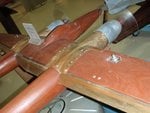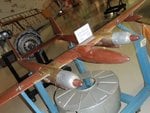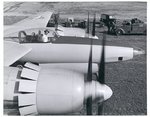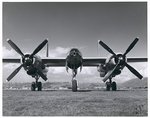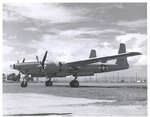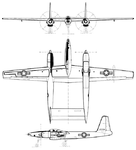Three view from an 'exclusive' article in an Australian magazine called Air Historian from 1973. I cannot vouch for its accuracy. The photos in the article are of a very poor quality and heavily retouched.

The man in the foreground is 'possibly' Howard Hughes.

This is the only photo I could find of the D-2 on the net.

Does anyone have any further images of this aircraft? Hughes of course was very secretive and possibly few photos exist. General H.H. Arnold (according to the article) flew to Hughes' factory to inspect the D-2, but was refused entry by security guards, as Hughes left strict instructions that no-one be allowed entry. Nevertheless Hughes always believed that his basic idea for the D-2 had not been the best kept secret and was convinced that the government had conspired to give a production contract for the P-38 Lightning to Lockheed as a result of his early intensive research work on a revolutionary twin-engine interceptor design.
Four months after Howard Hughes had submitted a design for a twin -engine interceptor to the Army Corps, they issued specifications for an identical craft to four companies. Hughes testified that Hughes engineers had gone to work for Lockheed.

The man in the foreground is 'possibly' Howard Hughes.

This is the only photo I could find of the D-2 on the net.

Does anyone have any further images of this aircraft? Hughes of course was very secretive and possibly few photos exist. General H.H. Arnold (according to the article) flew to Hughes' factory to inspect the D-2, but was refused entry by security guards, as Hughes left strict instructions that no-one be allowed entry. Nevertheless Hughes always believed that his basic idea for the D-2 had not been the best kept secret and was convinced that the government had conspired to give a production contract for the P-38 Lightning to Lockheed as a result of his early intensive research work on a revolutionary twin-engine interceptor design.
Four months after Howard Hughes had submitted a design for a twin -engine interceptor to the Army Corps, they issued specifications for an identical craft to four companies. Hughes testified that Hughes engineers had gone to work for Lockheed.
Clarence L. (Kelly) Johnson, Lockheed designer, already had made preliminary drawings of a similar machine, both with single fuselage, later to be modified to twin tail booms. Was it coincidence? Or was it simply an example of parallel development? Howard Hughes considered the coincidence 'strange'.




